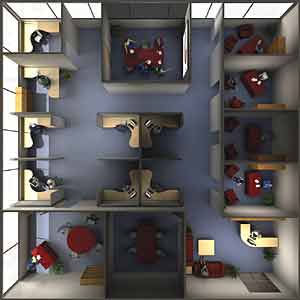The Essential Design Element for Any Office Space
Lighting systems represent a significant operational expense. Today, more electricity is used to light a typical building than is used to heat, cool, secure, or otherwise operate the structure. It is estimated that roughly 10% of all of the electricity consumed in the United States is used to light commercial buildings and, in 2005, that electricity cost Corporate America over $7 billion.
Rising energy costs have spurred a re-examination of how commercial spaces are using their kilowatt-hours. Systems designed to provide more light than necessary, minimal light control, and few light level options have been identified as three reasons why the lighting bills are unnecessarily high.
|
While the presence of light is essential for an office space to be functional, lighting systems are often designed to provide more light than necessary for typical office tasks. The Illuminating Engineering Society of North America (IESNA) recommends that the office building should be equipped to provide between 30-50 footcandles on a workspace. Fluorescent lamps are highly efficient and currently the industry standard in commercial construction. However, as fluorescent lamps age, their light output diminishes. Lamp output is also reduced when the lamps become dusty and dirty. To ensure that there is always enough light present in the office space, many lighting systems are designed to compensate for the diminished output and, subsequently, regularly provide more light than is needed.
Lighting control can be a design tool that promotes space flexibility and energy savings. Incorporating only the most basic or minimal light control on a project locks the building’s lighting resource into a rigid and uncompromising structure that wastes energy as unused lights are kept on. For example, in private offices light switches are often placed conveniently near the door. This switch location makes it easier for employees to turn the lights off before they leave their office space, saving energy and money. In the shift from private office spaces to open office spaces, switches now control large groups of lights located over desks that may be vacant for a significant portion of the day. A lighting control system that ties 20 light fixtures to one light switch unnecessarily wastes energy by keeping all of the lights on, even if only half of the people are in their seats.
Beyond the operational expense of keeping overhead lights on when the desk is empty and providing more light than necessary on the workspace, providing no available light range between 100% and off can unnecessarily tax the human element of the office. Too much light exposure has adverse affects on people’s health, mood, and performance. The squinting and strange postures employees strike to avoid glare and unnecessarily bright conditions cause headaches, fatigue, and muscle aches.
Although the reactions to the wrong light level may be fairly routine, the light levels considered right and wrong differ from person to person. Health conditions, preferences, age, and task are factors that combine to create the unique visual environments ideal for each individual employee. Providing inappropriate lighting levels in the workplace have been linked with productivity losses, reduced attention spans, and dissatisfaction. Lighting systems in office spaces can be easily designed to match employee preferences by incorporating dimming technologies in the overhead lights. This improved controllability has been credited with improving individual employee productivity 4-7%, reducing eyestrain, and improving worker satisfaction.
Incorporating more lighting control and offering a wider range of light levels throughout the office space saves energy, improving the efficiency of the lighting system, and adds value to the space by making it a more comfortable and productive place to work. Designing lighting control into an organizational space simultaneously supports environmental interests and sustainable design guidelines, equips the building to work smarter and be more profitable, and accommodates the company’s most valuable asset.










